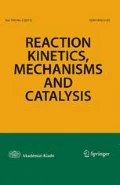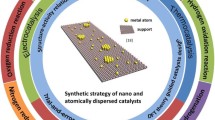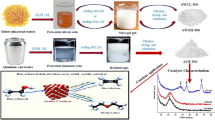Abstract
A kinetic study for the isomerization of α-pinene epoxide over Fe/SBA-15 and Fe/MCM-41 catalysts was developed using a pseudo-homogeneous (polynomial law) and heterogeneous (LHHW formalism with one and two actives sites) models. TEM analysis of Fe/SBA-15 and Fe/MCM-41 showed that the materials have the typical hexagonal organization; FTIR adsorption–desorption of pyridine revealed the presence of Lewis acidity in both Fe/SBA-15 and Fe/MCM-41 catalysts. The presence of Fe3+ and Fe2+ species was concluded from XPS analysis; however, active site for α-pinene epoxide isomerization was attributed to Fe3+. With toluene as solvent, it was found that in both catalysts, the more adequate kinetic model was the unimolecular LHHW model with two active sites of the same type. Apparently, α-pinene epoxide isomerization is much faster over Fe/MCM-41 (5.78 L h−1 gFe−1) than over Fe/SBA-15 (1.14 L h−1 gFe−1). The activation energy for both Fe catalysts was evaluated using solvents of different polarity. In the case of Fe/MCM-41, the less energetic barrier was observed with toluene (30.99 kJ mol−1), while tert-butanol (13.76 kJ mol−1) was more favorable in the case of Fe/SBA-15 catalyst. Fe/MCM-41 is a very robust catalyst because it can be used up to four times without a significant loss of catalytic activity in comparison with Fe/SBA-15 that only can be used two times. Finally, a reaction mechanism was proposed for the isomerization of α-pinene epoxide over both Fe/SBA-15 and Fe/MCM-41 catalysts.










Similar content being viewed by others
References
Golets M, Ajaikumar S, Mikkola J (2015) Catalytic upgrading of extractives to chemicals: monoterpenes to “eXICALS”. Chem Rev 115:3141–3169. https://doi.org/10.1021/cr500407m
Carr G, Dosanjh G, Millar AP, Whittaker D (1994) Ring opening of α-pinene epoxide. J Chem Soc Perkin Trans 2(7):1419–1422
Stekrova M, Kumar N, Aho A, Sinev I, Grünert W, Dahl J, Roine J, Arzumanov SS, Mäki-Arvela P, Murzin DY (2014) Isomerization of α-pinene oxide using Fe-supported catalysts: selective synthesis of campholenic aldehyde. Appl Catal A 470:162–176. https://doi.org/10.1016/j.apcata.2013.10.044
Shcherban N, Barakov RY, Mäki-Arvela P, Sergiienko SA, Bezverkhyy I, Eränen K, Murzin DY (2018) Isomerization of α-pinene oxide over ZSM-5 based micro-mesoporous materials. Appl Catal A 560:236–247. https://doi.org/10.1016/j.apcata.2018.05.007
Pitínová-Štekrová M, Eliášová P, Weissenberger T, Shamzhy M, Musilová Z, Čejka J (2018) Highly selective synthesis of campholenic aldehyde over Ti-MWW catalysts by α-pinene oxide isomerization. Catal Sci Technol 8:4690–4701. https://doi.org/10.1039/C8CY01231H
Bruno S, Pillinger M, Kühn FE, Gonçalves IS, Valente AA (2013) Isomerization of α-pinene oxide in the presence of methyltrioxorhenium(VII). Catal Commun 35:40–44. https://doi.org/10.1016/j.catcom.2013.02.001
Coelho JV, De Meireles A, Da Silva Rocha K, Pereira M, Oliveira L, Gusevskaya E (2012) Isomerization of α-pinene oxide catalyzed by iron-modified mesoporous silicates. Appl Catal A 443–444:125–132. https://doi.org/10.1016/j.apcata.2012.07.030
Breitmaier E (1997) Common fragrance and flavor materials: preparation, properties and uses. Wiley-VCH, Toronto. https://doi.org/10.1002/9783527612390
Schulze K, Uhlig H (1989) Riechstoffsynthesen mit Fencholenaldehyd. Chem Mon 120:547–559. https://doi.org/10.1007/BF00810841
Reactions of alkenes. Addition reaction of alkenes. Masachuset University. https://www2.chemistry.msu.edu/faculty/reusch/VirtTxtJml/addene1.htm. Accessed 27 Jul 2019
Nucleophilic substitution of epoxides. University of Calgary. http://www.chem.ucalgary.ca/courses/350/Carey5th/Ch16/ch16-6-1.html. Accessed 27 Jul 2019
Yosra L, Ahmed S, Stuart J, Tatiana P, Bassem S, Keun-Hang S, Frank C, Neil S, Murat O (2016) Inhibition of human a7 nicotinic acetylcholine receptors by monocyclic monoterpene carveol. Eur J Pharmacol 776:44–51. https://doi.org/10.1016/j.ejphar.2016.02.004
Bathia S, McGinty D, Letizia C, Api A (2008) Fragrance material review on carveol. Food Chem Toxicol 46:S85–S87. https://doi.org/10.1016/j.fct.2008.06.032
Muhammad Z, Amjad A, Hong-Quan D, Jiwu Q, Faiz-Ur R (2019) Anticancer activity and mechanism of bis-pyrimidine based dimetallic Ru(II)(η6-p-cymene) complex in human non-small cell lung cancer via p53-dependent pathway. J Inorg Biochem 194:52–64. https://doi.org/10.1016/j.jinorgbio.2019.01.019
Wishart DS et al (2018) HMDB 4.0: the human metabalome database for 2018. Nucleic Acids Res 46:D608–D617
Kim S et al (2016) Campholenic aldehyde and their properties. Nucleic Acids Res 44(D1):D1202–D1213
Wishart DS, Tzur D, Knox C et al (2007) HMDB: the human metabolome database. Nucleic Acids Res 35:D521. http://www.hmdb.ca/metabolites/HMDB0034973
Timofeeva M, Panchenko V, Abel A, Khan N, Ahmed I, Ayupov A, Volcho K, Jhung S (2014) Rearrangement of α-pinene oxide to campholenic aldehyde over the trimesate metal-organic frameworks MIL-100, MIL-110 and MIL-96. J Catal 311:114–120. https://doi.org/10.1016/j.jcat.2013.11.006
Neri G, Rizzo G, Crisafulli C, De Luca L, Donato A, Musolino M, Pietropaolo R (2005) Isomerization of α-pinene oxide to campholenic aldehyde over Lewis acids supported on silica and titania nanoparticles. Appl Catal A 295:116–125. https://doi.org/10.1016/j.apcata.2005.07.027
Stekrova M, Kumar N, Díaz S, Mäki-Arvela P, Murzin D (2015) H- and Fe-modified zeolite beta catalysts for preparation of trans-carveol from α-pinene oxide. Catal Today 241:237–245. https://doi.org/10.1016/j.cattod.2013.12.004
Stekrova M, Kumar N, Mäki-Arvela P, Ardashov O, Volcho K, Salakhutdinov N, Murzin D (2013) Selective preparation of trans-carveol over ceria supported mesoporous materials MCM-41 and SBA-15. Materials 6:2103–2118. https://doi.org/10.3390/ma6052103
Kaminska J, Schwegler MA, Hoefnagel A, Van Bekkum H (1992) Recl des Trav Chim des Pays-Bas 111(10):432–437. https://doi.org/10.1002/recl.19921111004
Liebens A, Mahaim C, Holderich W (1997) Selective isomerization of alpha-pinene oxide with heterogeneous catalysts. In: Blaser HU, Baiker A, Prins R (eds) Heterogeneous catalysis and fine chemicals IV, vol 108. Elsevier, Amsterdam, pp 587–594
Stekrova M, Kumar N, Mäki-Arvela P, Aho A, Linden J, Volcho K, Salakhutdinov N, Murzin D (2013) Opening of monoterpene epoxide to a potent anti-Parkinson compound of para-menthane structure over heterogeneous catalysts. Reac Kinet Mech Cat 110:449–458. https://doi.org/10.1007/s11144-013-0615-9
Ravasio N, Zaccheria F, Gervasini A, Messi C (2008) A new, Fe based, heterogeneous Lewis acid: selective isomerization of α-pinene oxide. Catal Commun 9:1125–1127. https://doi.org/10.1016/j.catcom.2007.10.019
Timofeeva M, Panchenko V, Hasan Z, Khan N, Mel’Gunov M, Abel A, Matrosova M, Volcho K, Jhung S (2014) Effect of iron content on selectivity in isomerization of α-pinene oxide to campholenic aldehyde over Fe-MMM-2 and Fe-VSB-5. Appl Catal A 469:427–433. https://doi.org/10.1016/j.apcata.2013.10.016
Sidorenko A, Kravtsova A, Aho A, Heinmaa I, Kuznetsova T, Murzin D, Agabekov V (2018) Catalytic isomerization of α-pinene oxide in the presence of acid-modified clays. Mol Catal 448:18–29. https://doi.org/10.1016/j.mcat.2018.01.021
Sánchez-Velandia J, Villa-Holguín A (2018) Optimización de la síntesis de aldehído canfolénico a partir del epóxido de α-pineno con Cu/MCM-41. Rev Colomb Química 47:13–23
Sánchez-Velandia J, Villa A (2019) Isomerization of α and β pinene epoxides over Fe or Cu supported MCM-41 and SBA-15 materials. Appl Catal A 580:17–27
Wroblewska A, Miadlicki P, Makuch E (2016) The isomerization of α-pinene over the Ti-SBA-15 catalyst—the influence of catalyst content and temperature. Reac Kinet Mech Cat 119(2):641–654
Mäki P, Nataliya A, Lozachmeur C, Russo V, Wärnå J (2018) Isomerization of α-pinene oxide: solvent effects, kinetics and thermodynamics. Catal Lett 149:203–214. https://doi.org/10.1007/s10562-018-2617-8
Vicevic M, Boodhoo K, Scott K (2007) Catalytic isomerisation of α-pinene oxide to campholenic aldehyde using silica-supported zinc triflate catalysts. I. Kinetic and thermodynamic studies. Chem Eng J 133:31–41. https://doi.org/10.1016/j.cej.2006.11.014
Saminen E, Maki-Arvela P, Virtanen P, Olavi-Salmi T, Warna J, Mikkola J (2015) Kinetics upon isomerisation of a, b pinenes epoxides over supported ionic liquids catalystst (SILCAs) containing Lewis acids. Ind Eng Chem Res J 53:20107–20115
Cai C, Zhang Z, Zhang H (2016) Electro-assisted heterogeneous activation of persulfate by Fe/SBA-15 for the degradation of orange II. J Hazard Mater 313:209–218. https://doi.org/10.1016/j.jhazmat.2016.04.007
Arruebo M, Ho W, Lam K, Chen X, Arbiol J, Santamaría J, Yeung K (2008) Preparation of magnetic nanoparticles encapsulated by an ultrathin silica shell via transformation of magnetic Fe-MCM-41. Chem Mater 20:486–493. https://doi.org/10.1021/cm703269w
Stockenhuber M, Hudson M, Joyner R (2009) Preparation, characterization and unusual reactivity of Fe-MCM-41. J Phys Chem B 104:3370–3374
Li H, Chen J, Wan Y, Chai W, Zhang F, Lu Y (2007) Aqueous medium Ullman reaction over a novel Pd/Ph-Al-MCM-41 as a new route of clean organic synthesis. Green Chem 9:273–280
Lázaro Martínez J, Rodríguez-Castellón E, Sánchez R, Denaday L, Buldain G, Campo Dall’Orto G (2011) XPS studies on the Cu(I, II)-polyampholyte heterogeneous catalyst: an insight into its structure and mechanism. J Mol Catal A 339:43–51. https://doi.org/10.1016/j.molcata.2011.02.010
Yan Y, Wu X, Zhang H (2016) Catalytic wet peroxide oxidation of phenol over Fe2O3/MCM-41 in a fixed bed reactor. Sep Purif Technol 171:52–61. https://doi.org/10.1016/j.seppur.2016.06.047
Boroń P, Chmielarz L, Gurgul L, Łątka K, Gil B, Marszałek B, Dzwigaj S (2015) Influence of iron state and acidity of zeolites on the catalytic activity of FeHBEA, FeHZSM-5 and FeHMOR in SCR of NO with NH3 and N2O decomposition. Microporous Mesoporous Mater 203:73–85. https://doi.org/10.1016/j.micromeso.2014.10.023
Derouane E, Védrine J, Ramos Pinto R, Borges R, Costa L, Lemos M, Lemos F, Ramôa Ribeiro F (2013) The acidity of zeolites: concepts, measurements and relation to catalysis: a review on experimental and theoretical methods for the study of zeolite acidity. Catal Rev Sci Eng 55:454–515. https://doi.org/10.1080/01614940.2013.822266
Das S, Asefa T (2011) Epoxide ring-opening reactions with mesoporous silica-supported Fe(III) catalysts. ACS Catal 1:502–510. https://doi.org/10.1021/cs1001256
Davis E, Davis R (2003) Fundamentals of chemical reaction engineering. McGraw-Hill, New York. https://doi.org/10.1021/ed043pa758.1
Acknowledgements
J.E.S.-V. acknowledges to COLCIENCIAS (call 785-2018) and instructor program of Universidad de Antioquia for their doctoral fellowship. The authors acknowledge to COLCIENCIAS and Universidad de Antioquia for financial support through Project CT 059-2016.
Author information
Authors and Affiliations
Corresponding author
Additional information
Publisher's Note
Springer Nature remains neutral with regard to jurisdictional claims in published maps and institutional affiliations.
Rights and permissions
About this article
Cite this article
Sánchez-Velandia, J.E., Agudelo-Cifuentes, A. & Villa, A.L. Kinetics of the isomerization of α-pinene epoxide over Fe supported MCM-41 and SBA-15 materials. Reac Kinet Mech Cat 128, 1005–1028 (2019). https://doi.org/10.1007/s11144-019-01656-z
Received:
Accepted:
Published:
Issue Date:
DOI: https://doi.org/10.1007/s11144-019-01656-z




